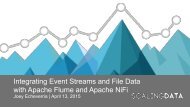NCDS-Summit-2013
NCDS-Summit-2013
NCDS-Summit-2013
Create successful ePaper yourself
Turn your PDF publications into a flip-book with our unique Google optimized e-Paper software.
In addition, the complexity and interconnectedness of biological<br />
systems are increasingly recognized, and analyses<br />
are often based on integrated data sets from multiple sources,<br />
which can be challenging due to heterogeneous and incomplete<br />
data. Privacy issues become important considerations<br />
when working with data sets from multiple sources,<br />
as do issues related to provenance.<br />
In the context of genomics, there has been a move away<br />
from the era of candidate gene studies to an era in which<br />
thousands to millions of variants can be identified for an individual<br />
patient and the causal one(s) then needs to be identified<br />
(Figure 5). This “N=1” approach is particularly difficult<br />
when one is looking for rare sequence variants causing<br />
Mendelian disease because each individual has thousands of<br />
help overcome some of the challenges involved in identifying<br />
rare disease-causing variants in a given individual.<br />
However, this approach presents additional challenges. For<br />
example, technical approaches to federate data across disparate<br />
systems are often insufficient or not widely adopted.<br />
Sampling issues are also important to consider when using<br />
large data sets because sample populations for genomic<br />
studies are often homogeneous, thus rendering the possibility<br />
for incorrect inferences. Similarly, while large data sets<br />
enable risk assessment and diagnostics, correlation does not<br />
equal causation. Conditional probabilities with confidence<br />
intervals can suggest that a rare variant causes a specific disease,<br />
but this approach does not provide a definitive conclusion<br />
regarding the disease-causing rare variant(s) because<br />
Figure 5.<br />
Classification of<br />
Disease-Causing<br />
Sequence Variants<br />
by Allele Frequency<br />
and Effect Size.<br />
(From Manolio et<br />
al., Nature 461:747-<br />
753, 2009. Reprinted<br />
with permission<br />
from Nature Publishing<br />
Group.).<br />
rare sequence variants in their genome, each of which (alone<br />
or in combination) could alter gene function. The challenge<br />
is complicated by a bias toward looking for variants in the<br />
coding region of genes, primarily because these are easier<br />
to identify and interpret; however, for mutations with low<br />
penetrance, the disease-causing variant(s) may not be in the<br />
coding region. A further complication is that alterations in<br />
pathways and systems may be more important than a mutation<br />
in a single gene, so there is a need to map not only single<br />
gene mutations but mutations along an entire pathway<br />
or system. Environmental influences also are not well understood.<br />
Another challenge when dealing with rare variants<br />
is insufficient or absent phenotype data. For example, rare<br />
neurological diseases are often described using ill-defined<br />
terms, in part because neurologists have not reached consensus<br />
on the clinical features of rare neurological diseases.<br />
Large data sets drawn from multiple sources of data can<br />
a genomic hypothesis cannot be directly tested under controlled<br />
conditions, thus requiring that findings are validated<br />
in independent data sets. In addition, confidence intervals<br />
may be unacceptably large to draw any conclusions regarding<br />
the relationship between a rare variant and disease.<br />
Large data sets may also help to identify the genetic architecture<br />
for common but complex traits (e.g., substance<br />
abuse). Heritability patterns for complex genetic traits are<br />
not always clear, with “missing” heritability customary.<br />
Large data sets may facilitate the identification of biologically<br />
important patterns within genomic data that may help<br />
to explain complex genetic traits or define new complex<br />
traits.<br />
Challenges in the analysis of genomic data are complicated<br />
by the fact that analysts often are not adequately<br />
trained to work with massive data sets. A 2011 McKinsey<br />
Global Institute Report projects that by 2018, the<br />
Data to Discovery: Genomes to Health / page 9




